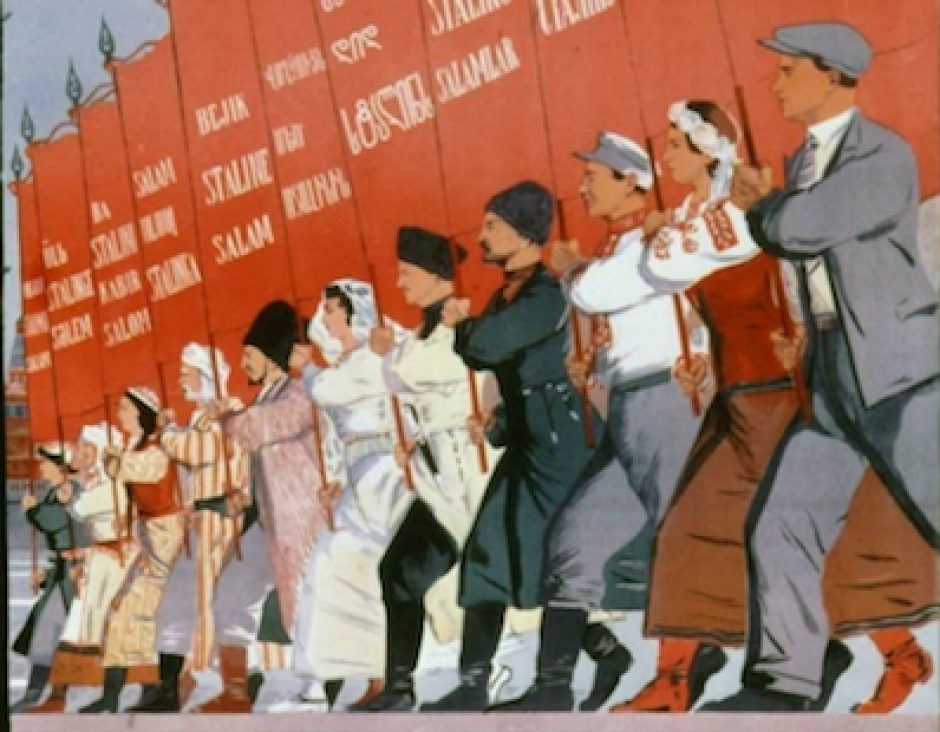I saw three main reasons, according to Weinberg, that Soviet leaders planned the settlement of the Jewish Autonomous Region. First, they hoped it would produce a non-religious Jewish cultural identity rooted in the Yiddish language and in socialism; second, they aimed for economic transformation of Jews from petit bourgeoisie to “productive Soviet citizens” engaged in agricultural labor; third, they thought that it would address geopolitical problems such as peasant unrest in Ukraine and Belarus and anxieties about Chinese and Japanese expansionism in the east. I want to focus on the first reason: the cultural aims and impacts of the planned Jewish resettlement in Birobidzhan.
Weinberg notes that Lenin and Stalin staunchly opposed the classification of Jews as a national minority group. Jews in Russia and in the Pale of Settlement were perceived as not having ties to any particular land and as often engaged in less-than-honest economic activity. There seems to be some continuity in perceptions and solutions here as tsarists, who predated the J.A.R. project, and zionists, who opposed it, all felt as the Bolsheviks did that agricultural resettlement would alter Jewish culture so as to end the “Jewish problem” (18-19). Of course, planned Jewish settlement in the far east was unique to the Bolsheviks, and this plan seems to have provided Soviet Jews unprecedented freedom of movement. How else can we relate or distinguish the J.A.R project to tsarist or zionist schemes to resettle Jews?
In his introduction, Weinberg is quick to note that the J.A.R. was ultimately a failed project. “The Jews of Birobidzhan have lived the fiction that they inhabited the national homeland of Soviet Jewry,” he writes (13). And it is easy to see the evidence of this failure when he quotes, for example, a Soviet journalist who wrote, “‘The colonization of Birobidzhan was begun and executed without preparation, planning and study. All the misfortunes are due to the hasty manner’ in which the Birobidzhan project was implemented.” The number of migrants who eventually left the J.A.R. or gave up on farming bolster this judgment. But I think it will also be important to investigate what could perhaps be called the cultural successes of the J.A.R. between 1928 and the mid-1930s.
The Stalinist strategy for promoting appropriate national culture seems to have consisted of similar combinations of vernacular theater, schools, and newspapers, all with a healthy dose of propaganda. But not every observer of the J.A.R. project reacted cynically to its cultural project. Weinberg writes, “Well known Yiddish writers and Jewish intellectuals visited the J.A.R. in the 1930s and affirmed the official line that the Birobidzhan project embodied the national and cultural aspirations of Soviet Jewry… It must be remembered, however, that the political climate in the 1930s required writers to tailor their work to fit the uniform ideological mold established by the regime” (61-62). In the final section of the reading we see some evidence of how cultural production was attempted in the J.A.R., as well as how it was portrayed to the outside world (posters on pp. 35-39, 44-50). In what ways, if any, can these sections be construed as evidence for successful cultural construction? How does Soviet officials’ partial failure to suppress religious observation fit into this schema (65)? And why was the idea of Jewish resettlement in Soviet East Asia briefly able to gain some traction among Jews around the world?
One last quote for consideration: “In contrast to the stultifying religious environment and grinding poverty of the shtetl, the J.A.R. signaled the dawn of a new age for Jews, an age in which Soviet Jews would express contempt for Jewish tradition, free themselves of the burdens, limitations, and prejudices of the past, and glorify Soviet power as they became integral members of the socialist society under construction” (63).

I’m interested in your about the relative successes of Yiddish culture as well, because I didn’t find Weinberg very conclusive on this topic. There is a strong case for Jewish culture elsewhere in the USSR: although Weinberg talks about how Jews elsewhere in the Soviet Union were attracted to the Russian language for the sake of mobility, (p71) and I think the Brown reading, in an aside about Hasidic religious leaders in Kiev, also illustrated how Jewish religious life could survive elsewhere in the USSR without the framework of “Yiddishism.”
A more specific way to pose your question, then, might be this: what were the successes of building a Yiddish proletarian culture (see Stalin’s “Tasks of the University…”) appropriate to the JAR’s aspirations to become a national homeland? What was distinctive about it, in comparison to Jewish culture in the rest of the USSR?
“In what ways, if any, can these sections be construed as evidence for successful cultural construction? How does Soviet officials’ partial failure to suppress religious observation fit into this schema (65)?”
I found the information regarding private religious observance to be an indication of the possibility that Jewish culture was not altogether under Soviet control. For this one documented case of service being held in a private apartment, there may have been many times more cases where the practitioners kept it secret, and so undocumented. It is nearly impossible to know for certain whether the chilling effect created by such events as anti-religious speeches during Passover on the factory floor was enough to dissuade Jews from still engaging in group religiosity.
Regarding your closing quote, I again say that it’d be very difficult to generalize for certain that all Soviet Jews jettisoned Judaism. They may have been pressured and expected to do so, but just as likely as they are to cave in, they are likely to conceal their true loyalties—some of them, not necessarily all.